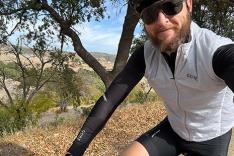
Below is an excerpt from the book "The No-Drop Zone: Everything You Need to Know About the Peloton, Your Gear, and Riding Strong" by Patrick Brady. The 250-page book outlines all aspects of road cycling for beginners, from riding skills to bike gear to the cycling lifestyle. Learn more about the book here.
Riding with no hands on the bar is an essential skill every rider needs. On its own, the skill is a great education in how a bike corners and how you can control your bike simply by shifting your weight at the saddle and pedals. It is handy for adjusting zippers, glasses, and helmets on the fly.
When learning how to ride with no hands, make sure your speed is at least 15 mph. Move your hands to the bar top and then simply sit up straight. With practice you'll find that you can turn and even do upper body stretches.
"My favorite domestique moment occurred during the Tour DuPont in 1994, when I was riding for the Coors Light team," says Joe Parkin. "One of my teammates wanted a Coke, but not in the can. In a very compact peloton going down a long descent at about 45 mph I sat up and poured the contents of the can into his water bottle. I'm sad to say that I've probably done that kind of thing more times than I've been able to raise both hands high over my head for a victory salute."
Eating
Once you know how to ride no-hands, you can eat while riding, which is an important skill if you want to avoid bonking. Begin by removing the bar or gel from your jersey pocket. Sit up quickly and tear the wrapper open. In the case of a bar, pull the wrapper down enough to expose the bar and then put one hand back on the handlebar.
Dressing and Undressing
In many places temperatures can change significantly over the course of the day. Morning riders may find themselves stripping off arm warmers and vests as the day heats up, while some riders may find a need to add these pieces in the afternoon. Similarly, you may need to strip off pieces at the bottom of a long climb or put them back on at the top when you begin the descent.

Frankly, undressing is the easier of the two. With arm warmers, hook your thumb over the top hem and pull it down to your wrist. Sit up briefly and pull it off over your glove. Put one hand back on the bar and stuff the arm warmer into the nearest pocket. Repeat. Be careful to pull the arm warmer forward off your hand and not sideways. If you pull sideways you risk hitting another rider and crashing.
In some places, temperatures can go from hot to cold and back again based on the terrain. Sometimes it can be most helpful to just push the arm warmers down to your wrists for the climb and then pull them back up for the descent if the climb isn't too long and you don't anticipate stopping at the top.
More: Buy arm warmers for your next ride.
Removing a vest requires sitting up a little longer. Begin by unzipping the vest with one hand. Sit up and grab each side of the front of the vest with each hand (left side with left hand, right side with right hand). Pull the vest straight backward; do not pull down, as it may get hooked on your shoulders. Once it's over the shoulders, pull one hand out of the armhole and bring the vest in front of you. Quickly wad it up and stuff it in your center pocket. You may need to hold the pocket open with your other hand to stuff it down.
Jackets follow the same method as vests, but because of the addition of arms, it is easier to get fabric caught in the drivetrain or rear wheel; there's also more pulling involved in getting the arms out of the sleeves. If you know you'll take it off during the ride and you may not have a chance to stop to take it off, a vest is safer.
More: Don't get cold on the bike. Shop for a new cycling jacket.
Putting arm warmers on isn't too hard; you just have to give a firm pull to get the arm warmer over your gloved hand and be sure to hold your arm forward and pull back toward your body.
Should you be on a ride that isn't stopping much or for long and you need to put on a vest, proceed with caution. Pull the vest out of your pocket and give it a shake to open it. Sit up and bring it in front of you to make sure it isn't tangled—the zipper will sometimes catch on an armhole. Put one arm through an armhole. Reach behind your head and take the collar with both hands and walk your hands to the edge of the collar opposite the side of the vest you have on. Use your hand to hold the collar out as far as possible and slip your arm through the armhole. Then run your hands down the zipper to the bottom and zip it up.
This is an extremely difficult process and you should only attempt it if a group won't stop and you feel chilled. Plenty of pros have trouble doing this.
Parkin says not to worry if you can't dress while you're on the bike. "While racing, I couldn't put on a rain jacket or vest to save my life. For that reason, if I felt I might need the thing later, I would just leave it on, opened, letting it just flap in the wind."
More: Get the right cycling apparel for your ride.
 Ready to go? Search for a cycling event.
Ready to go? Search for a cycling event.About the Author









Discuss This Article